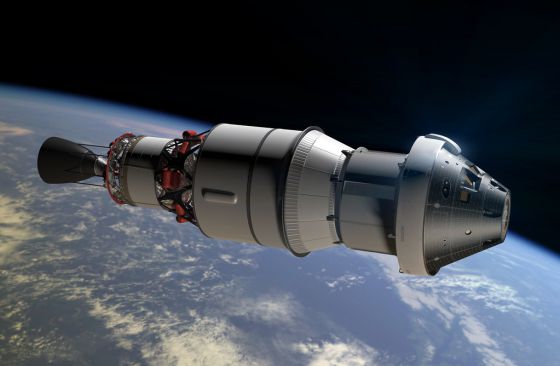
Illustration of Orion space capsule attached to the service module and the last stage of the Delta IV rocket. / NASA
The Orion capsule, the new spacecraft that NASA develops, is prepared on a Delta IV Heavy rocket to take off on 4 December at 13.05 CET Spanish, from the spaceport at Cape Canaveral in Florida. It is proof of spaceflight this vehicle. The weather forecast is a 70% favorable to launch, which can be done in a margin of two hours and 39 minutes. The Orion is the first spacecraft (designed to be manned) which tests for NASA in space from the ferry, finally retired in 2011, and the first developed for astronauts to travel to deep space from the capsules of the Apollo moon program the sixties and seventies.
In the first test flight of space without astronauts aboard the Orion prototype will withdraw up to 5,800 kilometers of land area (the International Space Station orbiting around 420 miles high) serving nearly two orbits around the Earth before re-entering the Earth’s atmosphere. It will travel 96,600 kilometers in total. The engineers, who have already made numerous partial testing of the components of the Orion, now want to see how withstands radiation in space and, above all, reentry into Earth’s atmosphere to fall into the Pacific Ocean, about a thousand kilometers west of Baja California.
In the Orion, which should be ready by 2017 or 2018 automatic flight, and in 2021 for astronauts to be tested during this first flight several key components, explains NASA, as security system for astronauts encore later dismissed from the ship if a problem occurs at launch or promotion of the rocket, and the separation of the service module (with the propulsion and life) before re-entry atmosphere. Regarding this last phase of the trial, the Orion penetrate into the air to 32,000 mph and its heat shield will have to withstand 2,200 degrees centigrade by friction. Guidance systems, onboard computers and parachutes that will slow the end, before falling to water is also checked. Will be collected in the Pacific by the strength of the US Navy. The test costs 300 million euros.
The Orion, built by Lockheed Martin for NASA, weighs 21 tons and 8.6 tons release capsule alone, after removal from the service module. With a truncated cone, the ship measures 3.3 meters in height and five in diameter, with two and half times the volume of the capsules that were used in the Apollo program. In his version manned can travel up to six astronauts
On the way to Mars
The NASA considers the Orion spacecraft, and test flight Thursday as a step toward future travel astronauts to Mars, perhaps in the thirties. The other element up those plans are the future super power rockets Space Launch System. “In the not too distant future, astronauts destined to be the first humans to walk on Mars, will leave the Earth in a spacecraft Orion,” said NASA in a statement.
But the US space agency no start or a real program funded manned the red planet with multiple, complex and expensive items that require addition of a capsule for astronauts leave the Earth. As for his previous plan to move a small asteroid to the vicinity of the Moon for astronauts go on Orion to study and sampling, has the support of President Obama, but has the green light from Congress to the budget necessary. What it does have and that plan are numerous criticisms of institutions and experts, including reports from the National Research Council and the
Advisory Council of the NASA“The ARM (Asteroid Redirect Mission) will never be funded, never will be done. Is throwing money away. No means no progress and report any benefits that may be achieved by more efficient and inexpensive means, “said Mark Sykes resounding, director of the Planetary Science Institute, last September, before a parliamentary committee, reports the journal Nature. As for the National Research Council, described the proposal capture mission and visit an asteroid as a “dead end” on the way to Mars.
The NASA, working on the design of the ARM argues that the propulsion requirements demanded by mission, as well as technologies develop, will serve as a test bed for other plans, including the manned trips to Mars. “The ARM tested new technologies such as solar electric propulsion that will help us to send heavy loads to Mars before human missions,” said NASA in a statement. “The astronauts aboard the Orion will return to Earth with samples from the asteroid, having tried numerous tools that we will use in future human missions to Mars and its moons.”
No comments:
Post a Comment